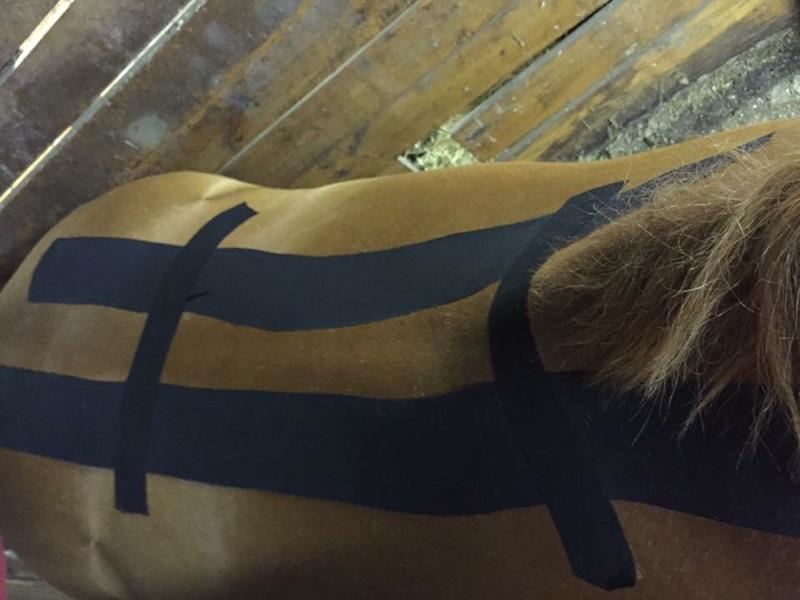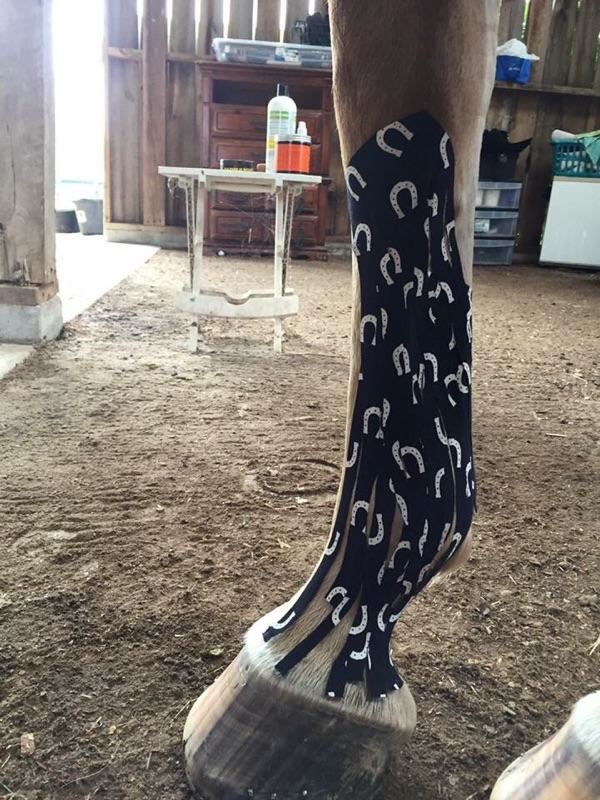You may have seen horses warming up for shows wearing what looks like colorful Vet Wrap on their bodies, laid out in lines almost mimicking their skeleton. Just what IS this tape and what does it do?
By Sarah E Coleman

The horse world has made some rapid advances in the last two decades: Acupuncture and chiropractic care are more mainstream, and herbal remedies and other techniques now have their place in most veterinarian’s toolboxes. Kenisiotape, one of the newest modalities on the block, is rapidly gaining a following among both riders and equine health professionals.

Dr. Anna Hichborn Dunlap of Creek Hollow Veterinary Services in Georgetown, Ky., is licensed in chiropractic care, acupuncture, laser therapy and kenisiotaping; she services Kentucky, Georgia, Florida and New York. She began using kenisiotape in 2012, but took a long break from the modality until seeing it used again on Kerri Walsh Jennings at the Rio Olympics.
“There is really no magic or medicine [to kenisiotape] … it’s just a stretchy tape that’s very sticky. The top of the tape has a fabric-like feel and are often lycra/cotton blends, depending on the brand,” she explains. While this may not seem like a modality that would see a lot of benefits, Dr. Dunlap explains that the tape can be used for a variety of issues. “[Kinesotape] is used for pain reduction, physical and mechanical support of joints and muscles, to improve lymphatic and blood circulation, and to help patients of any species with body awareness issues (proprioception).”
The tape is applied directly to the skin or hair, sometimes sticking with the help of spray adhesives. “Tensions are applied across the tape and the degree of tension will vary by the application, like supporting a joint versus a muscle group,” she explains.
But How Does It Work?
Kenisiotape works in a variety of ways, depending on the reason for use. “For pain management, the stretch across the tape causes the skin tension to up-regulate motion sensing nerves, which will in turn decrease pain-sensing nerves,” Dr. Dunlap says. When kenisiotape is used to improve blood flow, it decompresses skin, creating an almost vacuum-like environment that encourages blood and lymph flow, she notes.
For joint and muscle stabilization, the kenisiotape is applied to mimic the natural structure of the joint. And for proprioception, the tape increases consciousness of body parts in space.
Results can be seen immediately for joint and muscle stabilization. The other techniques are affecting the nervous and circulatory systems, so results will be evident with time and may require reapplication of tape.
In Dr. Dunlap’s practice, she uses kinesiotape a lot for painful cases and has had good results on neck and back pain. Recently she treated an older mare that had many foals. Her owner noticed that she wasn’t rolling anymore and looked stiff behind. I did sacroiliac support taping and she immediately went out and rolled on both sides, then took off bucking. Her tape stayed on for 12 days!
There are not really any injuries on which she would not use the tape, but she does not recommend using the tape around malignancies because the increased circulation to the area would essentially “feed” the malignant cells, risking spreading them at an increased rate.
Does it Stick Well?
Stickability of the tape depends, says Dr. Dunlap. “During the summer, sweat is a big factor and during the winter, hair is a big factor!” In all the horses Dr. Dunlap has worked on, “some tape has come off in an hour (annoying) and some has stayed on for up to 12 days (unicorn!)!”
So, how is it removed? Most of us envision pain and hair pulling with this process! “You don’t pull it off like a Band-Aid--you roll it back over itself. Using baby oil or a silicone spray can help with the removal. Unless the horse is showing, I encourage [riders and owners to] leaving it on till it falls off and just trimming the ends if they peel up.”

How Often Does it Need Reapplied?
Kinesiotape is used differently in different applications. For tape used for support and to treat edema, it will likely need to be applied more than once. Tape used for pain relief typically only requires only one application, but Dr. Dunlap notes that she is usually adjusting or acupuncturing the horses, as well.
The results seen with the tape depend on the application, says Dr. Dunlap. There is the reduction of pain and swelling, and mechanical support of joints. “The proprioceptive technique should decrease injury by increasing the body's awareness of its various parts while exercising, leading to a more-correct technique from the athlete,” She explains. “Think of using this technique on a rider's back, making them more aware of their position and decreasing the incidence of back injury while jumping,” she offers as an example.

History of Kinesiotape
Kinesiotaping was developed in Japan in the 1970s by Dr. Kenzo Kase, who was a human chiropractor. He was looking for a modality his patients could use in between visits to his office. “It started as an experiment by someone with a good working knowledge of anatomy that ended up helping a lot of people,” says Dr. Dunlap.
While those who apply kinesiotape do not have to be certified to apply it, it’s necessary that whomever applies the tape have a good working knowledge of equine anatomy to be affective. Dr. Dunlap recommends working closely with your vet it you have performance concerns with your horses.
Rider Beware
At this time, kinesoptape can only be used on horses at rated competitions while they are in the stall. As the rules are changing (and USEF, USEA and USDF all have or had annual meetings in the last few weeks), riders will need to be up-to-date on the rule changes regarding kinesiotaping and how they apply to their level of showing.
Additionally, though riders can buy the tape and learn how to apply it, it’s imperative that riders first consult with their veterinarian on any performance issues they are having.
